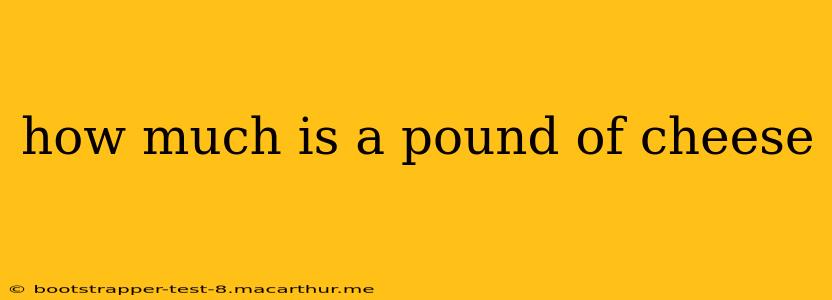How Much is a Pound of Cheese? A Deep Dive into Dairy Prices
The price of a pound of cheese is surprisingly variable! There's no single answer, as the cost depends on several crucial factors. This guide will break down the influencing elements and help you understand what you can expect to pay for your next cheese purchase.
What Kind of Cheese?
This is perhaps the most significant factor. A pound of artisanal, aged cheddar will cost considerably more than a pound of processed American cheese slices. Consider these price ranges:
- Processed Cheese: Often the most affordable, you might find a pound of processed cheese for $5-$8. This price is highly dependent on brand and location.
- Common Cheeses (e.g., cheddar, mozzarella): Expect to pay anywhere from $8 to $15 per pound for standard varieties. Store brands generally fall on the lower end, while name brands or those with specific aging processes will be more expensive.
- Specialty Cheeses (e.g., brie, goat cheese, aged gouda): These cheeses can range from $15 to $30 or even more per pound, depending on the cheese's rarity, aging, and production methods. The price increases significantly as you move into more exclusive cheeses.
Where Do You Buy Your Cheese?
Location significantly impacts pricing. A pound of cheese at a local farmer's market will likely be more expensive than the same cheese at a large supermarket chain. Consider these purchasing options:
- Supermarkets: Generally offer the most competitive pricing on common cheeses, although selection might be more limited.
- Specialty Grocery Stores: Carry a wider variety of cheeses, including more expensive and artisanal varieties, but at a higher price point.
- Farmer's Markets: Support local producers but often charge a premium for their fresh, high-quality cheese.
- Online Retailers: Convenience comes at a cost, which might involve extra shipping fees, and price comparisons are essential.
What Affects Cheese Prices?
Several factors beyond the cheese type and location influence the final price:
- Milk Prices: The cost of milk, the primary ingredient in cheese production, significantly impacts the final product's price. Fluctuations in milk prices directly translate to changes in cheese prices.
- Demand: Seasonal changes, holidays, and even specific culinary trends can increase demand and thus drive up prices.
- Aging: Aged cheeses require more time and care, resulting in higher production costs and a higher price tag.
- Production Methods: Artisanal, handcrafted cheeses often involve more labor-intensive processes, leading to higher costs compared to mass-produced cheeses.
How Can I Save Money on Cheese?
- Buy in bulk: Larger quantities often translate to lower per-pound costs, especially at wholesale stores.
- Shop sales: Supermarkets and grocery stores frequently run sales on cheese, so keep an eye out for deals.
- Consider store brands: Store brands often offer comparable quality to name brands at lower prices.
- Look for less expensive cheeses: Experiment with different types of cheese; there are plenty of delicious options that don't break the bank.
What are the different types of cheese?
There's a vast world of cheeses! From the familiar cheddar and mozzarella to more exotic varieties like Roquefort and Pecorino Romano, the diversity is astounding. Each type has unique flavors, textures, and price points, dictated by milk type (cow, goat, sheep), production methods, and aging processes.
In conclusion, the cost of a pound of cheese is highly variable. By understanding the factors at play—cheese type, purchasing location, and market influences—you can make informed decisions and find the perfect cheese for your budget and taste.
